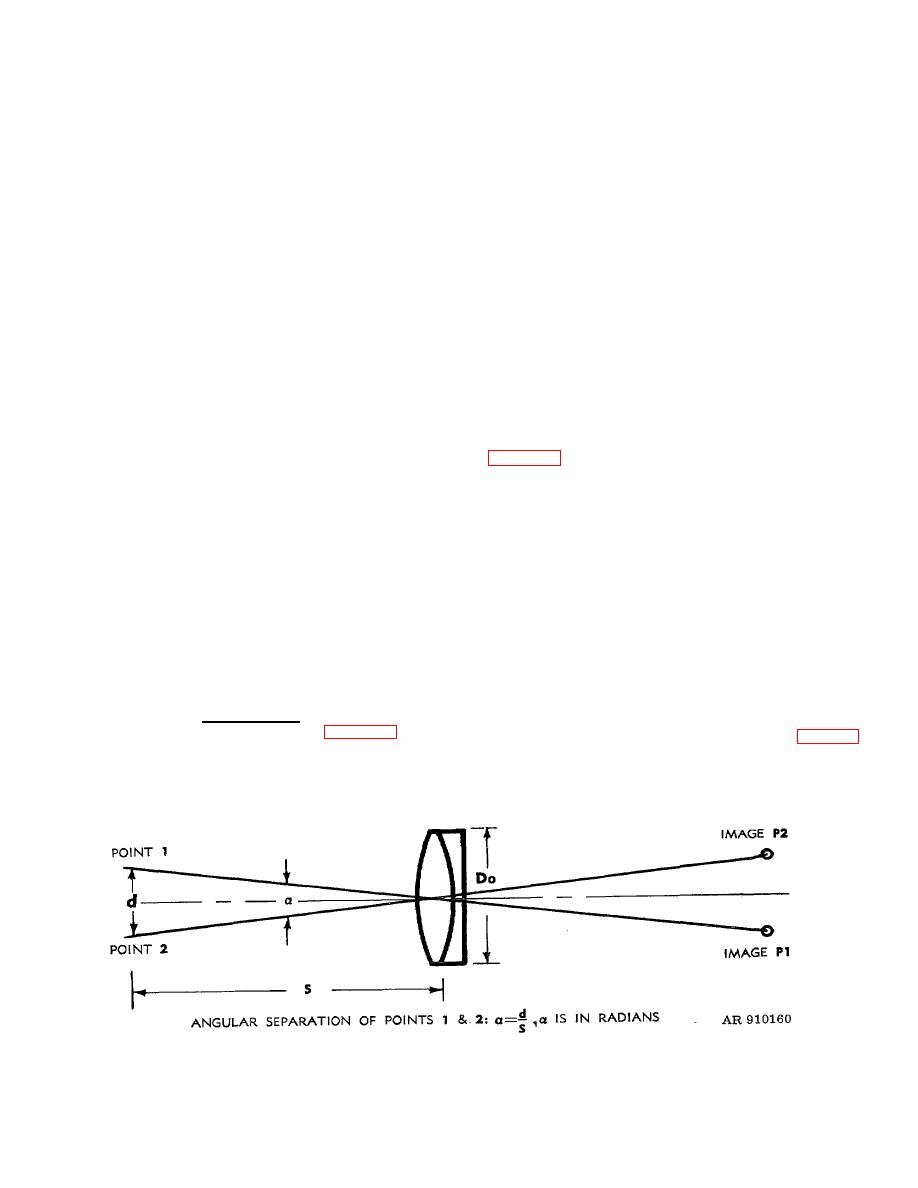 |
|||
|
|
|||
|
|
|||
| ||||||||||
|
|
 TM 9-258
c. Power of Eyepiece. Eye relief also is
illumination at any given light intensity, exit pupil of
instrument must equal entrance pupil of eye under the
inversely related to the power of the eyepiece; i.e.,
same condition.
Also, with any instrument, retinal
replacing a low-power eyepiece with one of higher power
illumination never is greater than with the unaided eye.
will reduce the eye relief.
Opaque foreign material such as dust or lint on any
5-28. Light Transmission or Ilumination.
optical surface, except one in a real image plane, will
a. Pupils.
The illumination of the image
reduce the illumination of the system.
depends on the amount of light received by the objective
and the specific intensity (whether bright daylight or
illumination(brilliant daylight), the entrance pupil of the
twilight) of these light rays. The amount of light received
eye may be stopped down to 2 millimeter diameter.
is determined by the diameter of the entrance pupil (clear
When used under this illumination, an optical instrument
aperture, abbreviated as AP) of the objective. The
need have an exit pupil only 2millimeter diameter. When
amount of light entering the eye is limited either by the
the eye is subjected to very faint illumination, as at night,
exit pupil of the instrument or the pupil of the eye,
the pupil opens to a diameter of 8 millimeters. Thus, for
whichever is smaller.
use at night an optical instrument must have an exit pupil
(1) An S x 30 (8-power, 30-mm diameter)
of at least 8 millimeters provide the pupil of the eye with
glass in daytime (eye pupil diameter of 5 millimeters),
all the light it will admit. The relationship between the
since amount of light entering the instrument is
size of the exit pupil and the power of an instrument is
proportional to area of entrance aperture and thus to the
2
square of its diameter, picks up (30/5 ) or 36 times as
important. For example, a 7 x 50 binocular is suitable for
much light as the naked eye. The area of the retinal
nighttime use because if the clear aperture of the
2
image in the eye, however, is 8 or 64 times as large as
objective (50) is divided by the power of the binocular (7)
with the unaided eye. Thus, we have 36 times as much
light distributed over an area 64 times as great, so
7;15 millimeters. This is able to pass approximately all
illumination on the retina is only 36/64 or 56.3 percent of
the light the eye pupil can use at its widest aperture.
that with the unaided eye.
Now a 7 x 35 binocular provides ample illumination in
(2) Consider now an 8 x 40 binocular. In
daytime because its exit pupil diameter is 5 millimeters,
2
this case the amount of light entering the eye is (40/5 or
which is larger than the eye's 2-millimeter opening under
64 times that entering the unaided eye. There is now 64
intense illumination and ample for its 5-millimeter
times as much light falling on an area 64 times as large
opening under moderate illumination but insufficient for
(power is 8, thus the comparative area of the retinal
the 8-millimeter eye opening at night.
2
image is 8 ). In this case, illumination is the same as
5-30. Resolving Power of Optical Systems.
with the unaided eye.
a. Definition. The numerical measure of ability of an
(3) In an 8 x 50 glass, illumination will not increase with a
optical system to distinguish fine detail is called resolving
5-millimeter eye pupil because the iris of the eye will stop
power. It is further defined as the reciprocal of the
and the extra light from the extra 10 millimeters of
smallest angular separation (angular limit of resolution)
diameter of the objective. Since,
between two points which can be distinguished or
resolved as separate points. Resolving power = 1/α,
Entrance Pupil
Power = Exit Pupil
where α = least angular separation in radians (fig 5-32).
the exit pupil of this 8 x 50 glass is 50/8 or 6.25
As the angle becomes smaller between two points that
millimeters; therefore, the eye pupil of 5 millimeters will
can be resolved, the resolving power increases and
not admit all this light.
definition, therefore, is better.
b. Maximum Illumination.
For maximum
Figure 5-32. Angular limit of resolution.
5-17
|
|
Privacy Statement - Press Release - Copyright Information. - Contact Us |